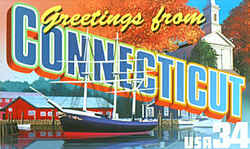


Connecticut Symbols
Connecticut Early History
First Early Inhabitants of Connecticut

Early history examines the archaeological record that tells the story of the first inhabitants of Connecticut. Learn about the prehistory and culture of the first early inhabitants, and what lessons it might teach us about the early history of Connecticut.
Connecticut First Early Inhabitants Timeline
- 16,000 BC - A mile-high glacier covered the area. (WSJ, 9/3/98, p.A16)
- 12,000 - 9,000 years ago - Paleo-Indian Culture Paleo-Indians inhabited the Connecticut region some 10,000 years ago, exploiting
the resources along rivers and streams. They used a wide range of stone tools and engaged in hunting, gathering, fishing, woodworking, and ceremonial
observances. They are thought to have been seminomadic, moving their habitations during the year to use resources that changed with the seasons.
The earliest dated human occupation site in the State is Templeton, located on the banks of the Shepaug River in Washington Depot.
When it was first found in 1977 and carbon-l4 dated to 10,190 years ago, it was the oldest known campsite in New England. It is still the only known deeply-buried, undisturbed, single-occupation, Paleo-Indian campsite having large quantities of tools used for a wide variety of functions. - 10,000 BC - The first indigenous people were of the Paleo-Indian culture who lived in caves or were Nomadic Hunters
- 9,000 - 3,000 years ago - Archaic Culture The Archaic stage is characterized by larger groups of people coming together in seasonal
camps who hunted smaller game such as deer, rabbit, turtle, frog, etc. A greater emphasis was placed on gathering nuts and vegetables than in the
Paleoindian stage. More diverse artifacts have been found in Archaic deposits such as ground stone tools, large, stemmed points, and stone vessels,
to name a few. The gradual advent of a new environment populated by different plant and animal species necessitated changes in the people's culture.
The most obvious change was in the development of tools for felling and limbing trees, for making dugout canoes from large logs, and for roughly shaping
logs. One also discerns development in fishing implements for netting, hooking, spearing, and trapping large numbers of fish.
Specialized food preparation implements were used to grind seeds and nuts. A hammerstone could have been used to break bones to extract marrow as well as to break rocks for making tools. Steatite (soapstone) bowls came into use late in the Archaic. Because such bowls conduct heat very well, they can be used for cooking directly over a fire.
In the Archaic, abundant evidence is found for the actual utilization of wild plant seeds, roots, bark, shoots, stalks, berries, and nuts. Many of the common plant species growing in gardens today as "weeds" were used by the Indians for food, (amaranth, purslane); medicine (yarrow); smoking (smartweed); beverage (goldenrod); dye (pokeweed); and raw materials for crafts (milkweed). - 9,000 BC - Caribou lived in the area. (WSJ, 9/3/98, p.A16)
- 7000 BC - Archaic Period in which people built basic shelters and made stone weapons and stone tools
- 3,000 to 400 years ago - Woodland Culture The use of domesticated plants occurred very late in New England because of the short growing season. The Indians had learned to exist upon the wild foods very comfortably and did not need horticulture. To depend upon new plants for one's very existence was to court disaster. Corn, beans, and squash, however, were grown to supplement their diet and tobacco was cultivated for rituals. The presence of settled villages at the time the Europeans arrived can be documented by records of traders and settlers.
- 1000 AD - Woodland period with permanent houses and farming
- 1614 - The first Europeans in Connecticut were Dutch traders
Early History of Native Americans in Connecticut
The Indigenous People of Connecticut
The names of the Connecticut tribes included the Narragansett, Mohegans, Wampanoag, Mohawk, Nipmuck, Pocumtuck, Abenaki and Pequot.
Before the arrival of European settlers in the 1500s and 1600s, Connecticut was home to a number of indigenous peoples.
Thousands of Native Americans lived in what is now the state of Connecticut before European settlers came to the area. They were all part of the Algonkian Indian family. The Pequot tribe was the most powerful. These Indians lived near the Thames River to the south. The Mohicans, a branch of the Pequot, lived near present-day Norwich.
These Native Americans gave the state its name. Connecticut comes from an Indian word "Quinatucquet," which means "Beside the Long Tidal River."
The Dutch navigator, Adriaen Block, was the first European of record to explore the area, sailing up the Connecticut River in 1614, and though the Dutch established a trading post, it was the British who fully colonized the area In 1633, Dutch colonists built a fort and trading post near present-day Hartford, but soon lost control to English Puritans migrating south from the Massachusetts Bay Colony.
The Pequot were hostile to colonial settlement and conducted frequent, violent raids. In May 1637 the English settlers, led mainly by Captain John
Mason and assisted by Mohegan and Narragansett warriors, attacked Pequot settlements on the Mystic River, sparking the Pequot War. The war pushed the
main body of the Pequot out of Connecticut and destroyed the resistance of those remaining, many of whom were enslaved by the Mohegans or English.





